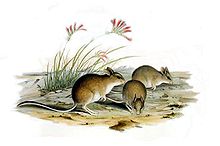- Mitchell's Hopping Mouse
-
Mitchell's Hopping Mouse 
Conservation status Scientific classification Kingdom: Animalia Phylum: Chordata Class: Mammalia Order: Rodentia Family: Muridae Genus: Notomys Species: N. mitchellii Binomial name Notomys mitchellii
(Ogilby, 1838)Mitchell's Hopping Mouse, Notomys mitchellii, is the largest extant member of the genus Notomys, weighing between 40 and 60 g (1.4 and 2.1 oz). N. mitchellii is a bipedal rodent with large back legs, similar to a jerboa or kangaroo rat. The species occurs throughout much of semi-arid Southern Australia, and appears to be particularly common on the Eyre Peninsula, South Australia. Typical habitat for N. mitchellii appears to be mallee shrublands on sandy dune systems. The species is currently considered to be unthreatened, but its range has been reduced through habitat disturbance and destruction associated with European settlement in Australia.
Individuals are a sandy grey colour, with white chest hairs and a paler underbelly. The tail of the species is long and has the characteristic hopping mouse brush at the tip. This tail morphology is thought to aid balance when travelling at speed. Being nocturnal, Notomys mitchellii shelters during the day in ‘typical’ hopping mouse burrows; a small number of interconnected, vertical shafts, burrowing deep into the dune. Up to eight animals, different ages and sex, have been found in a single burrow.
N. mitchellii is known to have a lifespan of up to five years in the laboratory and this is thought to be a strategy evolved to combat the breeding-constraints of lengthy periods of drought. It has also been found that this species is less able to cope with water deprivation than other species of the genus. Notomys mitchellii produces concentrated urine to conserve water, but in a different way to more arid-dwelling rodents. The diet of N. mitchellii is also thought to consist of more roots and green matter than that of other species of the genus: animals captured in drought conditions had stomach contents consisting of some 85% roots, 11% green leaf and 4% seed.
Contents
Phylogenetic Tree
On the phylogenetic tree is can be seen that the ancestor of the Mitchell’s hopping mouse diverged approximately 70million years ago. Mitchell’s hopping mouse is closely related to Dipodidae which is a northern hemisphere jumping rodents such as the jerboa. As their common ancestor diverged of an ancestor which evolved into creature which around the same time evolved again into families such as Pedetidae which consist of small hare like animals and Castoridae which are beavers.
Analogous Structure
An analogous structure off the Mitchell’s hopping mouse is their hind legs like the hind legs of a quokka or even a kangaroo. This structure is strong and muscular therefore allowing them to achieve power driven jumping covering more distance. This structure serves a similar purpose in the quokka and kangaroo either moving or jumping quickly from on coming predators.
Homologous Structure
An homologous structure the Mitchell’s hopping mouse is it’s long ears. As The Dipodidae family is closely related to the Muridae family as they diverged from the same common ancestor we can see the similarity of their ear structure which are seen to be very long. This can be used to hear their predators advancing towards allowing them to achieve a quick escape.
Further reading
- Watts CHS, Aslin HJ. 1981. The Rodents of Australia. London: Angus & Robertson
- Baverstock PR. 1979. A Three Year Study of the Mammals and Lizards of Billiatt Conservation Park in the Murrat Mallee, South Australia. South Australian Naturalist 53:52-8
- Strahan R, ed. 1998. The Mammals of Australia. The National Photographic Index of Australian Wildlife. Sydney, NSW: Reed New Holland

